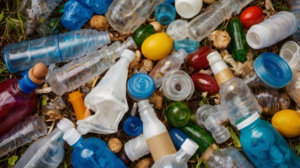Top 10 Hidden Environmental Health Risks Explained

Many dangers lurk in our environment, often unnoticed until it’s too late. These hidden environmental health risks can affect our well-being in ways we do not readily recognize. Being aware of these threats is crucial for both personal and community health. Understanding where these risks come from enables us to take proactive steps to protect ourselves and those around us. Awareness is the first step toward creating a healthier environment.
Indoor Air Quality
Common Indoor Pollutants
Indoor air quality can often be compromised by various pollutants. These include biological contaminants like dust mites and pet dander, which can trigger allergies and respiratory issues. Additionally, volatile organic compounds (VOCs) from cleaning products and paints can contribute to poor air quality.
Health Impacts
Research indicates that indoor air pollution is linked to significant health risks. The World Health Organization estimates that household air pollution leads to approximately 4.3 million premature deaths annually. Poor air quality can impair lung development in children and increase the risk of chronic conditions like COPD in adults. Maintaining clean indoor air is essential for preventing respiratory infections and other related health issues.
“Clean indoor air is vital for good health and well-being.”
By understanding these pollutants and their effects, we can take steps to improve our indoor environments, ensuring better health for ourselves and our families.
Contaminated Drinking Water
Contaminated drinking water poses a significant health risk, primarily due to sources like lead and pesticides. Lead can leach into water from old pipes and plumbing fixtures, particularly those installed before 1986. This toxic metal can accumulate in the body, leading to severe health issues, especially in young children.
Pesticides, used extensively in agriculture, can also seep into groundwater and surface water supplies. These chemicals can contaminate drinking water, posing risks depending on their concentration and toxicity.
Statistics highlight the urgency of this issue. In 2015, water pollution was responsible for 1.8 million deaths, and nearly half of U.S. rivers and streams are polluted, making them unfit for swimming and drinking. The following table illustrates contamination levels across different regions:
| Region | Contamination Level (%) |
|---|---|
| U.S. Rivers and Streams | 50 |
| U.S. Lakes | 33 |
| Global Water Pollution | 80 |
“Access to clean water is not just a necessity; it’s a fundamental right that we must protect for future generations.”
Addressing these contamination sources is crucial for ensuring safe drinking water and safeguarding public health.
Household Cleaning Products
Many household cleaning products contain harmful chemicals that can pose serious health risks. Awareness of these substances is crucial for maintaining a safe home environment.
Chlorine Bleach: Irritates eyes and throat; dangerous when mixed with ammonia.
Aerosol Sprays: Often contain VOCs that can lead to respiratory issues.
Detergents and Dish Soaps: May irritate skin and respiratory systems.
Air Fresheners: Release VOCs, which can cause headaches and other health issues.
Oven Cleaners: Contain caustic substances harmful if inhaled or ingested.
Pesticides: Chemicals like Dimpylate and Diazinon can impair the central nervous system.
Long-term exposure to these chemicals can lead to a range of health problems, including respiratory damage, headaches, and even liver and kidney damage. A study by the Environmental Working Group found that cleaning products might release hundreds of hazardous VOCs, significantly affecting indoor air quality.
“Consider using greener alternatives to protect your health and the environment.”
Making informed choices about cleaning products is essential for reducing these hidden risks.
https://blissfullway.com/sustainable-food-choices-for-a-greener-planet/
Pesticides in Food
Pesticides, such as DDT, are commonly used in agriculture to control pests. However, these chemicals can persist in soil and water for years, leading to significant environmental consequences. The process known as biomagnification occurs when these toxins accumulate through the food chain, affecting everything from plants to apex predators, including humans.
A striking statistic from the World Health Organization reveals that pesticide residues are found in over 80% of conventionally grown fruits and vegetables. This raises serious concerns about health risks, including reproductive issues and neurological disorders.
“Choosing organic produce can significantly reduce your exposure to harmful pesticides.”
Long-term exposure to pesticide-laden food can lead to severe health issues, including nausea, convulsions, and even long-term neurological damage. As consumer awareness grows, advocating for safer agricultural practices becomes essential for public health.
Lead Exposure
Lead exposure remains a significant environmental health risk, particularly in older homes and communities. Understanding where lead can be found is crucial for safeguarding health.
Sources of Exposure
Common sources of lead exposure include lead-based paint in homes built before 1978, lead dust from deteriorating paint, and contaminated soil, especially near busy roads. Additionally, drinking water can leach lead from old pipes and fixtures, posing a risk to families.
Lead can also be found in some imported toys, jewelry, and traditional medicines. Children are particularly vulnerable to lead exposure, as they may ingest lead dust or particles by putting contaminated objects in their mouths.
“Regular testing can help identify lead exposure early and allow for timely intervention.”
The health effects of lead exposure in children can be severe, including damage to the brain and nervous system, slowed growth, and learning difficulties. Even low levels of lead can negatively impact a child’s health, emphasizing the need for awareness and proactive measures.
Electronic Waste
The improper disposal of electronic waste (e-waste) poses significant environmental and health risks. E-waste often contains hazardous materials like lead, mercury, and cadmium. When these substances leach into the soil and water, they can cause serious health issues for exposed individuals.
Those involved in informal e-waste recycling are particularly at risk. They may inhale toxic fumes and dust, leading to respiratory diseases and neurological damage. Vulnerable populations, especially children and pregnant women, face even greater risks from these hazardous exposures.
| Country | E-Waste Generated (2022) | Recycling Rate |
|---|---|---|
| China | 20 million tonnes | Not provided |
| United States | 6.9 million tonnes | 17.4% |
| Global Total | 62 million tonnes | 22.3% |
In 2022, the world generated a record 62 million tonnes of e-waste, with projections indicating that this figure could rise to 82 million tonnes by 2030. Alarmingly, only 22.3% of e-waste generated was recycled properly.
“Responsible disposal and recycling of e-waste can mitigate health risks and protect our environment.”
Conclusion
In summary, the hidden environmental health risks discussed—from poor indoor air quality to the dangers of electronic waste—demand our attention. Awareness of these issues is crucial for both individual and community health.
By understanding these risks and taking proactive steps, such as supporting proper e-waste disposal, we can protect ourselves and our environment. Staying informed is the first step towards creating a healthier future for all.
FAQ
What are the main environmental health risks? Common risks include poor indoor air quality, contaminated drinking water, and exposure to hazardous chemicals from household products and e-waste.
How does e-waste impact health? Improperly disposed e-waste can release toxic substances like lead and mercury into the environment, leading to serious health issues, including neurological damage and cancer risks.
What practical steps can I take to reduce exposure? Choose eco-friendly cleaning products, ensure proper disposal of electronic devices, and advocate for better recycling practices in your community.
How can I improve indoor air quality? Regularly ventilate your home, use air purifiers, and reduce clutter to minimize allergens like dust mites and mold.
Why is awareness of these risks important? Being informed empowers individuals and communities to take action, ultimately improving public health and reducing environmental harm.







